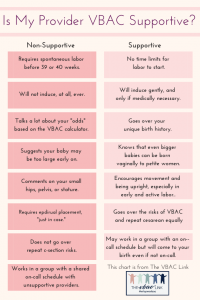

The benefits of a successful VBAC include lower risks of hemorrhage and/or infection and a quicker recovery time than a repeat cesarean.


The maternal risks of a TOLAC include endometritis, hysterectomy, uterine rupture and maternal death, and the risks for the baby include stillbirth, hypoxic ischemic encephalopathy and other conditions that will require admission to the neonatal intensive care unit (NICU). It’s important to talk to your provider about your concerns because both repeat cesareans and vaginal births after cesareans come with risks. “However, some rural hospitals may not have the support or resources to meet this standard.” Talking to your provider “There must be both an OB-GYN and anesthesiologist immediately available in the event that an emergency cesarean must be done,” White-Corey said. Women living in a rural community may need to plan to labor in a larger town or city. On the other hand, a recurring cause such as cephalopelvic disproportion (CPD), a condition when a baby’s head or body is too large to fit through the maternal pelvis, could mean that another cesarean birth may be the safer approach.

If there was a nonrecurring cause that required a previous cesarean birth, such as a breech presentation or fetal distress, then VBAC might be successful in this pregnancy-at least as long as the original cesarean birth wasn’t done with a vertical incision. Therefore, much of the decision depends on why the cesarean was done during the previous pregnancy. Some of these criteria include whether the mother has a clinically adequate pelvis (if she has given birth vaginally before), no other uterine scars or history of ruptures and if the patient has had one or two previous cesarean births with low transverse uterine incision (as opposed to a “classical” vertical incision, sometimes used for emergency cesarean births).
Tolac vs vbag trial#
“There are selection criteria that providers consider that can help determine the potential for successful VBAC whether a trial of labor is safe.” “A trial of labor isn’t for everyone,” White-Corey said. However, there are cases where attempting a trial of labor isn’t the best option, and it’s best to discuss your options with your provider early in the pregnancy. Some factors that influence the probability of a successful VBAC include prior vaginal birth, maternal age and time between pregnancy intervals. “There are a lot of factors that play a part in whether a VBAC is going to be successful, and the best thing that a mother can do is address the factors early on with her provider.” “Whether or not to attempt a trial of labor after cesarean must be decided by the woman and her provider after hearing and understanding all the risks and benefits to the woman and her unborn child,” said Shelley White-Corey, RNC, CNE, women’s health nurse practitioner and clinical assistant professor at the Texas A&M College of Nursing. Is a VBAC safe?Ī successful VBAC occurs when the baby is delivered without the need for cesarean, and it’s imperative that if a mother is hoping to attempt a TOLAC from the start, she should let her provider know right away. The decision about what type of birth to have has become more of a joint-decision between a mother and a provider, and an expert from the Texas A&M College of Nursing talks about what a mother-to-be should know about going through a vaginal birth after having a cesarean. According to the American College of Obstetricians and Gynecologists (ACOG), between 19, the cesarean birth delivery rate in the United States increased from 5 percent to more than 30 percent, and VBAC rates increased from 5 percent in 1985 to 28.3 percent in 1996 (although they have been declining since 2000). However, as cesareans became more common, this thinking slowly changed. For much of the 1990s and early 2000s, it was believed that once a woman had one cesarean birth, any subsequent birth would also require a cesarean, prompting the dictum “once a cesarean, always a cesarean.” Having a vaginal birth after a cesarean birth (VBAC) or going through a trial of labor after cesarean (TOLAC) is not unheard of, but that hasn’t always been the case.


 0 kommentar(er)
0 kommentar(er)
